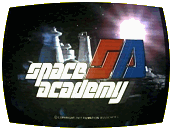- The Survivors Of Zalon
- Castaways In Time And Space
- Hide And Seek
- Countdown
- There’s No Place Like Home
- The Rocks Of Janus
- Monkey Business
- The Phantom Planet
- Planet Of Fire
- Life Begins At 300
- The Cheat
- My Favorite Marcia
- Space Hookey
- Star Legend
- Johnny Sunseed
After Filmation’s Ark II series completed production, there were no plans to continue it beyond its 15-episode run. While early ’70s science 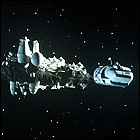 fiction TV was positively flooded with different takes on a post-apocalyptic world, it was a very limiting format. It also required expensive location filming, which was probably the final nail in Ark II’s coffin: there was no way to continue this show’s story in a studio-bound setting, because anyone coming into the vehicle (and therefore into the more manageable confines of its studio set) had to be shown encountering the vehicle. Ark II simply couldn’t be done without location filming, and was too expensive to continue.
fiction TV was positively flooded with different takes on a post-apocalyptic world, it was a very limiting format. It also required expensive location filming, which was probably the final nail in Ark II’s coffin: there was no way to continue this show’s story in a studio-bound setting, because anyone coming into the vehicle (and therefore into the more manageable confines of its studio set) had to be shown encountering the vehicle. Ark II simply couldn’t be done without location filming, and was too expensive to continue.
Filmation regrouped and set production into motion on a series concept by writer Allen Ducovny called Space Academy; perhaps not coincidentally, Ducovny started his TV career as one of the producers of the seminal 1950s science fiction TV series Tom Corbett: Space Cadet, one of the earlier examples of the genre on television, which took place at “Space Academy USA,” though there was no connecting tissue between the two shows other than the concept of an academy for space cadets.
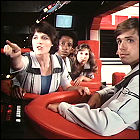 Relying heavily on the same format of action-with-strong-moral-lessons as Ark II, Space Academy was, by its nature, a studio-bound show, set on a large space station whose modular interiors could be reused extensively and redressed when needed. Even when Space Academy’s cadets set foot on other worlds, those worlds would be created in the studio, eliminating costly location shoots and equally costly delays caused by inclement weather.
Relying heavily on the same format of action-with-strong-moral-lessons as Ark II, Space Academy was, by its nature, a studio-bound show, set on a large space station whose modular interiors could be reused extensively and redressed when needed. Even when Space Academy’s cadets set foot on other worlds, those worlds would be created in the studio, eliminating costly location shoots and equally costly delays caused by inclement weather.
Space Academy was also slightly ahead of the curve: in May 1977, Star Wars premiered, and the public’s appetite for science fiction suddenly went into overdrive. Space Academy appeared in September of the same year, with impressive miniature model work that would’ve held up to prime-time scrutiny and a family-friendly space setting that was a bit tamer than the dangerous world of Luke Skywalker and friends. Newly sci-fi-addicted kids everywhere suddenly had a Saturday morning fix of space adventure.
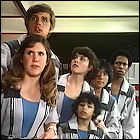 Space Academy also tips its hat to the original Star Trek, with a multiracial cast that was intended to be multinational as well (the character of Adrian was described as British in the series bible, though there’s no sign that actress Maggie Cooper was ever asked to affect an accent to that end). A child character, originally named Peepo (a name eventually bestowed upon the Academy’s resident robot), was introduced in the first episode and befriended by the Academy cadets who all seemed to be in their late teens and early 20s. Star Trek also seemed to have a strange hand in Space Academy’s casting as well: stars Pamelyn Ferdin and Brian Tochi had both been among the young cast members of the third-season Star Trek episode …And The Children Shall Lead, depicting the takeover of the Enterprise by children who have been given telepathic and telekinetic powers by a less-than-benevolent alien being.
Space Academy also tips its hat to the original Star Trek, with a multiracial cast that was intended to be multinational as well (the character of Adrian was described as British in the series bible, though there’s no sign that actress Maggie Cooper was ever asked to affect an accent to that end). A child character, originally named Peepo (a name eventually bestowed upon the Academy’s resident robot), was introduced in the first episode and befriended by the Academy cadets who all seemed to be in their late teens and early 20s. Star Trek also seemed to have a strange hand in Space Academy’s casting as well: stars Pamelyn Ferdin and Brian Tochi had both been among the young cast members of the third-season Star Trek episode …And The Children Shall Lead, depicting the takeover of the Enterprise by children who have been given telepathic and telekinetic powers by a less-than-benevolent alien being.
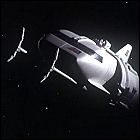 Space Academy did receive an inheritance from its predecessor, however: the studio set for the cockpit and interior of Ark II were kept intact, but extensively redecorated, to serve as Space Academy’s Seeker shuttle. The miniature model of the seeker was designed to reflect this hand-me-down, strongly echoing the shape of Ark II, while the “cockpit cone” of Ark II, removed from its truck chassis, was seen in at least two episodes of Space Academy where the cast needed to interact with a full-size model of the Seeker. Space Academy would similarly bequeath its models and sets to Filmation’s next live-action series.
Space Academy did receive an inheritance from its predecessor, however: the studio set for the cockpit and interior of Ark II were kept intact, but extensively redecorated, to serve as Space Academy’s Seeker shuttle. The miniature model of the seeker was designed to reflect this hand-me-down, strongly echoing the shape of Ark II, while the “cockpit cone” of Ark II, removed from its truck chassis, was seen in at least two episodes of Space Academy where the cast needed to interact with a full-size model of the Seeker. Space Academy would similarly bequeath its models and sets to Filmation’s next live-action series.
After production ended on 15 Space Academy episodes – the same number of Ark II episodes produced – plans were already underway to transform the series. The success of Star Wars had made its mark on the show’s producers, and Space 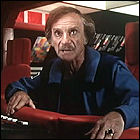 Academy was scheduled for an extensive reworking into an all-out action-adventure series. Plans were made to carry characters over from Space Academy to its new sequel, Jason Of Star Command, but Academy star Jonathan Harris was already in a dispute with Filmation over the rights to his likeness: Space Academy dolls had been produced, and Harris complained that the money from that merchandise was not being shared with the actors whose faces were being used. Commander Gampu’s planned graduation to Star Command never happened, and Harris was replaced by actor James Doohan. In the end, the only character to make the jump to the new series was the one “star” who could be counted on not to ask for more money: Peepo the robot.
Academy was scheduled for an extensive reworking into an all-out action-adventure series. Plans were made to carry characters over from Space Academy to its new sequel, Jason Of Star Command, but Academy star Jonathan Harris was already in a dispute with Filmation over the rights to his likeness: Space Academy dolls had been produced, and Harris complained that the money from that merchandise was not being shared with the actors whose faces were being used. Commander Gampu’s planned graduation to Star Command never happened, and Harris was replaced by actor James Doohan. In the end, the only character to make the jump to the new series was the one “star” who could be counted on not to ask for more money: Peepo the robot.
Brian Tochi, Ty Henderson, Jonathan Harris and Maggie Cooper continued to be familiar faces on TV, with Cooper eventually giving up acting for a career in TV journalism. Eric Greene, the youngest member of the cast, went on to launch a legal career, but maintained 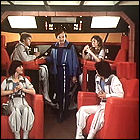 his affinity for science fiction; his book, “Planet Of The Apes As American Myth: Race And Politics In The Films And Television Series” (1996) has become required reading for fans of that franchise, and he even penned liner notes for the soundtrack of the TV version of Apes, which premiered and bowed out before Space Academy was ever produced. Pamelyn Ferdin continued acting, but has also become a sometimes controversial animal rights activist in recent years.
his affinity for science fiction; his book, “Planet Of The Apes As American Myth: Race And Politics In The Films And Television Series” (1996) has become required reading for fans of that franchise, and he even penned liner notes for the soundtrack of the TV version of Apes, which premiered and bowed out before Space Academy was ever produced. Pamelyn Ferdin continued acting, but has also become a sometimes controversial animal rights activist in recent years.
One can only assume that plucky Peepo has left Hollywood and ensconsed himself in Silicon Valley.

